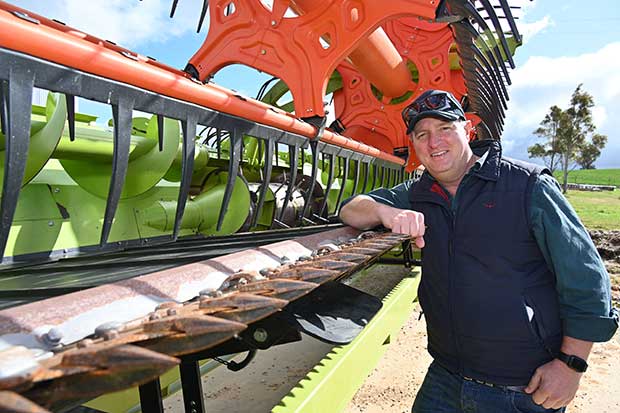Harvester fires can damage equipment, destroy crops and infrastructure and endanger life.
About seven per cent of harvesters start a fire each year, in a range of crop types including cereals and pulses. There is a chance that every grain grower will experience a harvester fire at some point.
Australian grain growers are also in a unique operating environment in terms of harvesting in conditions conducive to fires, but international harvester manufacturers are unlikely to significantly alter machine design or materials in response to specific Australian needs.

Kondinin Group engineer Ben White says grain growers should take steps to reduce the risk of harvester fires this season. Photo: Nicole Baxter
Kondinin Group engineer Ben White says about 50 per cent of harvester fires are caused by either failed bearings or insufficient harvester hygiene in combination with incendiaries emanating from hot exhaust components.
“An infrared heat gun is a perfect tool to use regularly throughout the day to determine if bearings are getting hotter,” Mr White says.
“Ideally, keep a record of your findings to determine if bearings are getting hotter – a sign of imminent failure.”
To eliminate dust and chaff build-up, Mr White says to improve harvester hygiene by blowing it down regularly with compressed air. A high-powered battery-operated leaf blower can also be a useful tool for clean-down and can be kept in the cabin for quick access.
“Those running weed seed impact mills may have to blow down their machines more frequently because they generate fine dust,” he says.
“Chickpea and lentil dust are among the worst for settling on exhaust systems and creating incendiaries due to their fine particle size and low smoulder point.”
It is also essential to ensure your harvester is fitted with the right style of fire extinguishers.
“I like to see one white band dry chemical powder (class ABE) and one red band water (class A) fire extinguisher near the cabin steps and the same combination at the rear of the machine,” Mr White says.
“A water extinguisher is useful to carry on the harvester to quickly put out small spots of burning crop. For powder-type extinguishers, tip them over once every 12 months to make sure the powder hasn’t clumped in the bottom, and they will need a recharge if they have been used at all.”
If you think conditions are too hot and windy to harvest, Mr White says, then it is likely that you should stop.
“There is an updated method of measuring fire weather risk now known as the Fire Behaviour Index (FBI) which replaced the Fire Danger Index. Get to know it and stop harvesting as the FBI approaches 40. Encourage your neighbours to do the right thing as well,” he says.
“Be proactive and sit down with your team before harvest to ensure everybody knows what to do and whom to contact, usually 000, if there is a fire.
“Also consider adding a water tank and pump to the chaser bin because the chaser bin driver is often first on the scene. Adding a remotely operated nozzle to the system will minimise the risk for operators.”
Grain growers are encouraged to take the following steps to reduce the risk of harvester fires this season:
- Regularly clean down machinery to reduce fuel load
- Monitor bearings with an infrared temperature gun
- Monitor ambient conditions and the fire behaviour index
- Ensure an electrical system isolator is used
- Ensure fuel system is well maintained
- Maintain and keep airflow systems clear
- Check concave doors are well sealed (minimise dust leakage which may contact hot surfaces)
- Ensure their harvest team has a plan and understands their responsibilities in the event of a fire.
Growers can access GRDC resources including the Reducing Harvest Fires Back Pocket Guide and the Harvester Forum Harvester Fires video.

























































